DC mesh current analysis
Question 1:
| Don't just sit there! Build something!! |
Learning to mathematically analyze circuits requires much study and practice. Typically, students practice by working through lots of sample problems and checking their answers against those provided by the textbook or the instructor. While this is good, there is a much better way.
You will learn much more by actually building and analyzing real circuits, letting your test equipment provide the änswers" instead of a book or another person. For successful circuit-building exercises, follow these steps:
- 1.
- Carefully measure and record all component values prior to circuit construction.
- 2.
- Draw the schematic diagram for the circuit to be analyzed.
- 3.
- Carefully build this circuit on a breadboard or other convenient medium.
- 4.
- Check the accuracy of the circuit's construction, following each wire to each connection point, and verifying these elements one-by-one on the diagram.
- 5.
- Mathematically analyze the circuit, solving for all values of voltage, current, etc.
- 6.
- Carefully measure those quantities, to verify the accuracy of your analysis.
- 7.
- If there are any substantial errors (greater than a few percent), carefully check your circuit's construction against the diagram, then carefully re-calculate the values and re-measure.
Avoid very high and very low resistor values, to avoid measurement errors caused by meter "loading". I recommend resistors between 1 kW and 100 kW, unless, of course, the purpose of the circuit is to illustrate the effects of meter loading!
One way you can save time and reduce the possibility of error is to begin with a very simple circuit and incrementally add components to increase its complexity after each analysis, rather than building a whole new circuit for each practice problem. Another time-saving technique is to re-use the same components in a variety of different circuit configurations. This way, you won't have to measure any component's value more than once.
Notes:
It has been my experience that students require much practice with circuit analysis to become proficient. To this end, instructors usually provide their students with lots of practice problems to work through, and provide answers for students to check their work against. While this approach makes students proficient in circuit theory, it fails to fully educate them.
Students don't just need mathematical practice. They also need real, hands-on practice building circuits and using test equipment. So, I suggest the following alternative approach: students should build their own "practice problems" with real components, and try to mathematically predict the various voltage and current values. This way, the mathematical theory "comes alive," and students gain practical proficiency they wouldn't gain merely by solving equations.
Another reason for following this method of practice is to teach students scientific method: the process of testing a hypothesis (in this case, mathematical predictions) by performing a real experiment. Students will also develop real troubleshooting skills as they occasionally make circuit construction errors.
Spend a few moments of time with your class to review some of the "rules" for building circuits before they begin. Discuss these issues with your students in the same Socratic manner you would normally discuss the worksheet questions, rather than simply telling them what they should and should not do. I never cease to be amazed at how poorly students grasp instructions when presented in a typical lecture (instructor monologue) format!
A note to those instructors who may complain about the "wasted" time required to have students build real circuits instead of just mathematically analyzing theoretical circuits:
What is the purpose of students taking your course?
If your students will be working with real circuits, then they should learn on real circuits whenever possible. If your goal is to educate theoretical physicists, then stick with abstract analysis, by all means! But most of us plan for our students to do something in the real world with the education we give them. The "wasted" time spent building real circuits will pay huge dividends when it comes time for them to apply their knowledge to practical problems.
Furthermore, having students build their own practice problems teaches them how to perform primary research, thus empowering them to continue their electrical/electronics education autonomously.
In most sciences, realistic experiments are much more difficult and expensive to set up than electrical circuits. Nuclear physics, biology, geology, and chemistry professors would just love to be able to have their students apply advanced mathematics to real experiments posing no safety hazard and costing less than a textbook. They can't, but you can. Exploit the convenience inherent to your science, and get those students of yours practicing their math on lots of real circuits!
Question 2:
A transistor is a semiconductor device that acts as a constant-current regulator. For the sake of analysis, transistors are often considered as constant-current sources:
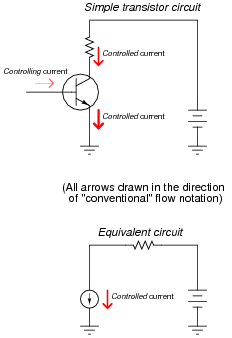
|
|
Suppose we needed to calculate the amount of current drawn from the 6-volt source in this dual-source transistor circuit:
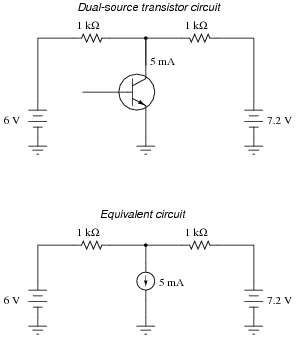
|
|
We know the combined currents from the two voltage sources must add up to 5 mA, because Kirchhoff's Current Law tells us that currents add algebraically at any node. Based on this knowledge, we may label the current through the 6-volt battery as "I", and the current through the 7.2 volt battery as "5 mA - I":
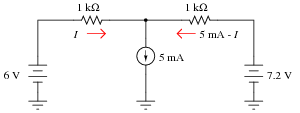
|
|
Kirchhoff's Voltage Law tells us that the algebraic sum of voltage drops around any "loop" in a circuit must equal zero. Based on all this data, calculate the value of I:
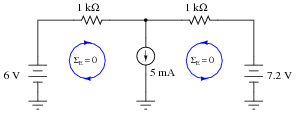
|
|
Hint: simultaneous equations are not needed to solve this problem!
Notes:
I wrote this question in such a way that it mimics branch/mesh current analysis, but with enough added information (namely, the current source's value) that there is only one variable to solve for. The idea here is to prepare students for realizing why simultaneous equations are necessary in more complex circuits (when the unknowns cannot all be expressed in terms of a single variable).
Question 3:
This transistor circuit is powered by two different voltage sources, one that outputs 6 volts, and the other that is variable.
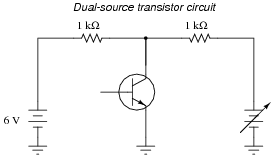
|
|
Transistors naturally act as current-regulating devices, and are often analyzed as though they were current sources. Suppose that this transistor happened to be regulating current at a value of 3.5 mA:
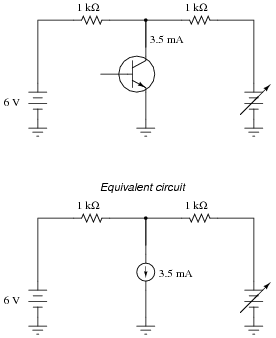
|
|
How high does the voltage of the variable source have to be adjusted, until no current is drawn from the 6-volt battery?
Hint: simultaneous equations are not needed to solve this problem!
Notes:
The purpose of this question is to get students to apply what they know of basic circuit "laws" (Ohm's Law, KVL, KCL) to the solution of a single voltage value. As usual, the method of solution is far more valuable than the answer.
If some students are completely confused regarding how to solve for this voltage, suggest that they "plug" the given answer into the circuit and determine currents and voltage drops. What do they notice when they do this? What unusual condition(s) stand out with the variable source at 9.5 volts? Are any of these conditions things they could have (or should have) known prior to knowing the variable source's voltage, given the condition of ". . . no current [drawn] from the 6-volt battery"?
Question 4:
Write two KVL loop equations for this circuit, using I1 and I2 as the only variables:
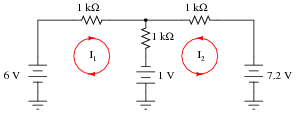
|
|
6 - 1000I1 - 1000(I1 + I2) + 1 = 0
KVL equation for right-hand loop:
7.2 - 1000I2 - 1000(I1 + I2) + 1 = 0
Follow-up question: what are the values of I1 and I2, based on this system of equations?
Notes:
Students' equations may not look exactly like these, depending on how they ßtepped" around the loops tallying voltage drops. So long as they are all able to reach the same answers for I1 and I2, it does not matter. In fact, it is a good thing to have different students propose different forms of the equations to demonstrate that the same answers are obtained every time.
Question 5:
Describe, step-by-step, the steps required to calculate all currents and voltage drops in a DC network using the Mesh Current Method.
Notes:
Students may find slight differences between variations of the "Branch Current" method of analysis described in different references. However, these differences are of no consequence.
Question 6:
Write the KVL equations for this circuit, given the following mesh current directions, and then solve for the charging current through battery #1:
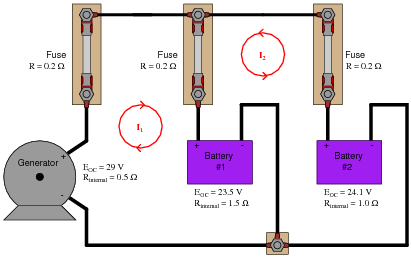
|
|
Now, write the KVL equations for the same circuit, after reversing the direction of mesh current I2. How does this reversal of mesh current I2 affect the writing of the two KVL equations, and also the calculation of the answer for battery #1's charging current?
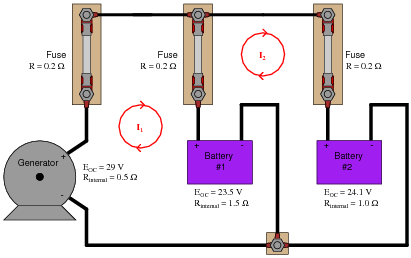
|
|
0.5I1 + 0.2I1 + 0.2(I1 + I2) + 1.5(I1 + I2) + 23.5 - 29 = 0
1.5(I1 + I2) + 0.2(I1 + I2) + 0.2I2 + I2 - 24.1 + 23.5 = 0
KVL equations with currents I1 and I2 meshing against each other through battery #1:
0.5I1 + 0.2I1 + 0.2(I1 - I2) + 1.5(I1 - I2) + 23.5 - 29 = 0
1.5(I2 - I1) + 0.2(I2 - I1) + 0.2I2 + I2 + 24.1 - 23.5 = 0
Ibat1 = 1.7248 A
Notes:
Your students may find the setup of KVL equations easier with the two mesh currents going in the same direction through battery #1, but they should be able to arrive at the same answer either way. It is very important to your students' understanding of the Mesh Current technique that they are able to handle both situations!
Question 7:
The "Mesh Current" method of network analysis works well to calculate currents in unbalanced bridge circuits. Take this circuit, for example:
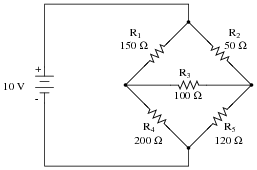
|
|
Write three mesh equations for this circuit, following these three mesh currents:
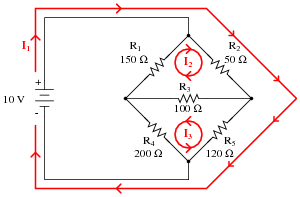
|
|
170I1 + 50I2 - 120I3 = 10
50I1 + 300I2 + 100I3 = 0
-120I1 + 100I2 + 420I3 = 0
Notes:
Students' equations may not look exactly like these, depending on how they ßtepped" around the loops tallying voltage drops. So long as they are all able to reach the same answers for I1, I2, and I3, it does not matter. In fact, it is a good thing to have different students propose different forms of the equations to demonstrate that the same answers are obtained every time.
Of special importance in this problem is how students represent two meshing currents at a single resistor in their equations. A common mistake for beginning mesh current analysts is to disregard the relative directions of meshing currents. It makes a huge difference whether two mesh currents go the same direction through a resistor, or whether they go in opposite directions!
Question 8:
A very interesting style of voltage divider appeared in an issue of Electronics, May 10, 1973. It used three series-connected strings of resistors and connection clips to provide 1000 steps of voltage division with only 31 resistors, of only 3 different resistance values:
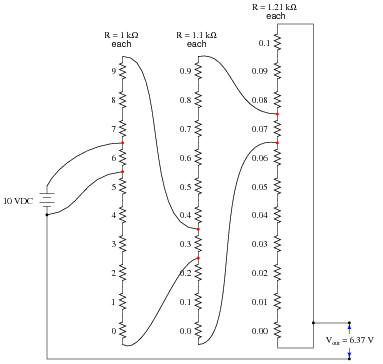
|
|
By moving the connection points between these strings of resistors, different fractions of the input voltage may be obtained at the output:
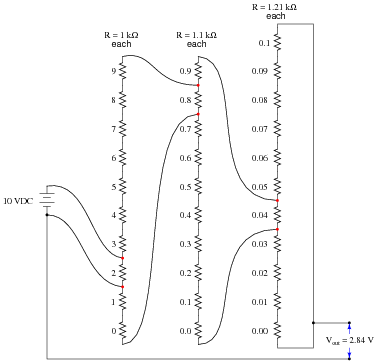
|
|
For the purposes of analysis, we may simplify any given configuration of this voltage divider circuit into a network of fewer resistors, in this form:
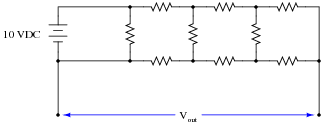
|
|
Draw the simplified networks for each of the two given configurations (Vout = 6.37 volts and Vout = 2.84 volts), showing all resistance values, and then apply mesh current analysis to verify the given output voltages in each case.
Note: you will have to solve a set of simultaneous equations: 4 equations with 4 unknowns, in order to obtain each answer. I strongly recommend you use a scientific calculator to perform the necessary arithmetic!
Notes:
There is a lot of setup work and arithmetic to do in the analysis of these two circuit configurations. This exercise is not only a thorough application of the mesh current method, but it also serves as an excellent application for computer simulation software. Give your students the opportunity to analyze both these circuits with simulation software, so they may appreciate the power of this technology.
Ask your students this question: "Suppose a student enters their circuit into a computer simulation program, and the program gives them an answer that is known to be incorrect. What does this indicate to the student?" Simulation tools are useful, both only so far as the user understands what he or she is doing. Far too often I encounter students who blindly accept the results of computer simulation, because they mistakenly think that whatever output the computer generates must be correct, not understanding how errors in the input or the use of different simulation algorithms affects accuracy of the simulated results.
